In pictures
VE Day, 8 May 1945
When it became increasingly clear that Allied victory over Nazi Germany in Europe was likely, plans were made by the British authorities to celebrate it – while considering that the war against Japan could still be taking place.
Cease Fire (Europe) Book
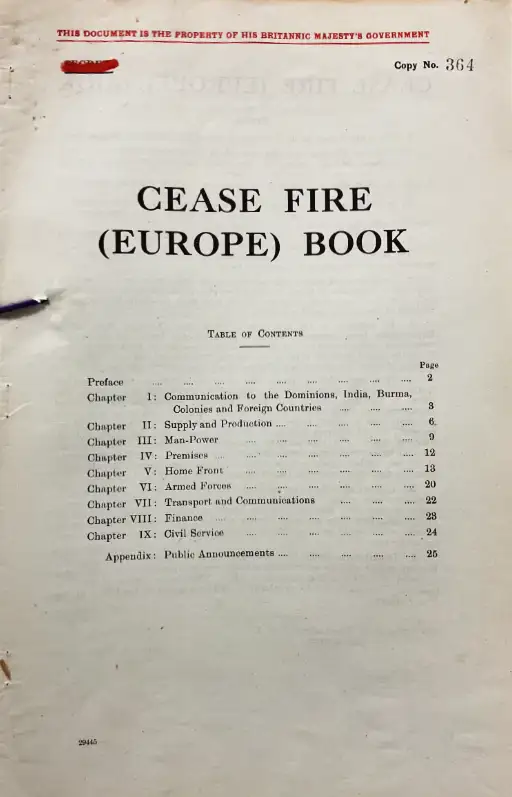
- Date
- 1945
- Catalogue reference
- HO 45/23203
This booklet was produced by the War Cabinet to provide details to government departments about the measures they should take in the days after hostilities cease in Europe. It was designed to ensure that any necessary decisions could take place ahead of time to ensure preparedness.
It includes details about how news of peace would be communicated to the dominions, India, and other foreign countries, and what actions needed to take place to divert supplies and materiel on the home and fighting fronts.
At this stage, the War Cabinet believed it was likely that there would be no clear-cut end to hostilities, but that they would come to end gradually over a period, and so any changes would also have to be gradual.
Home Office circular letter sent to local councils on the celebration of VE Day
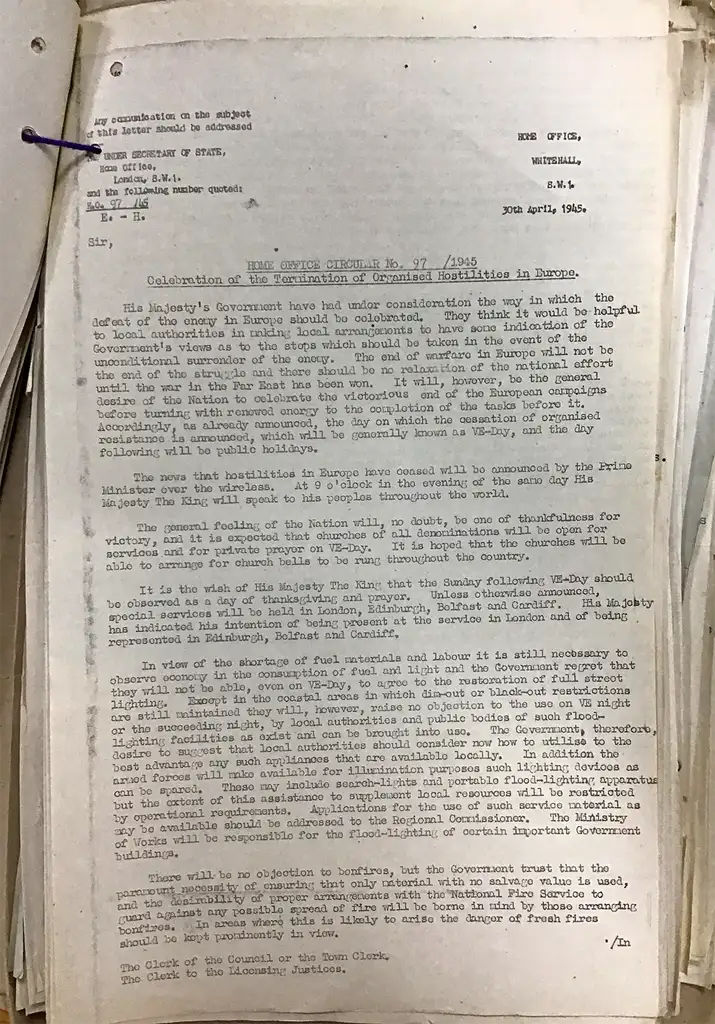
- Date
- 1945
- Catalogue reference
- CAB 21/1594
This letter was sent from the Home Office to local authorities encouraging them to make their own arrangements for the celebration of the end of hostilities in Europe. It stressed, however, that the end in Europe ‘will not be the end of the struggle and there should be no relaxation of the national effort until the war in the Far East has been won’.
It goes on to explain how the official announcement would be made, that there would be no objection to the lighting of bonfires, and that special exemptions would be given for licensing the sale of ‘intoxicating liquor’ subject to local circumstances.
It was made clear, however, that restraint should still be observed, especially regarding the consumption of fuel and light, and that even on this occasion, full street lighting would not be restored.
Memorandum by the Home Secretary and Minister of Home Security on arrangements for celebrating VE Day

- Date
- 1945
- Catalogue reference
- HO 45/23203
At a War Cabinet meeting on 3 April 1945, the Home Secretary and the Minister of Home Security set out arrangements for celebrating VE Day. They recommended that the announcement should be made by sounding the ‘All Clear’, the alarm used to signal safety after nearby bombing, for three minutes. It was further suggested that this, if possible, should occur at 11am, likely a recommendation to coincide with the usual two-minute silence on Remembrance Day.
It also includes recommendations for the broadcast of the news, that transport in London should be increased – assuming that the area would see an influx of people looking to celebrate – and that the ringing of church bells should be encouraged throughout the country.
Summary of main announcements proposed for VE Day and the following days
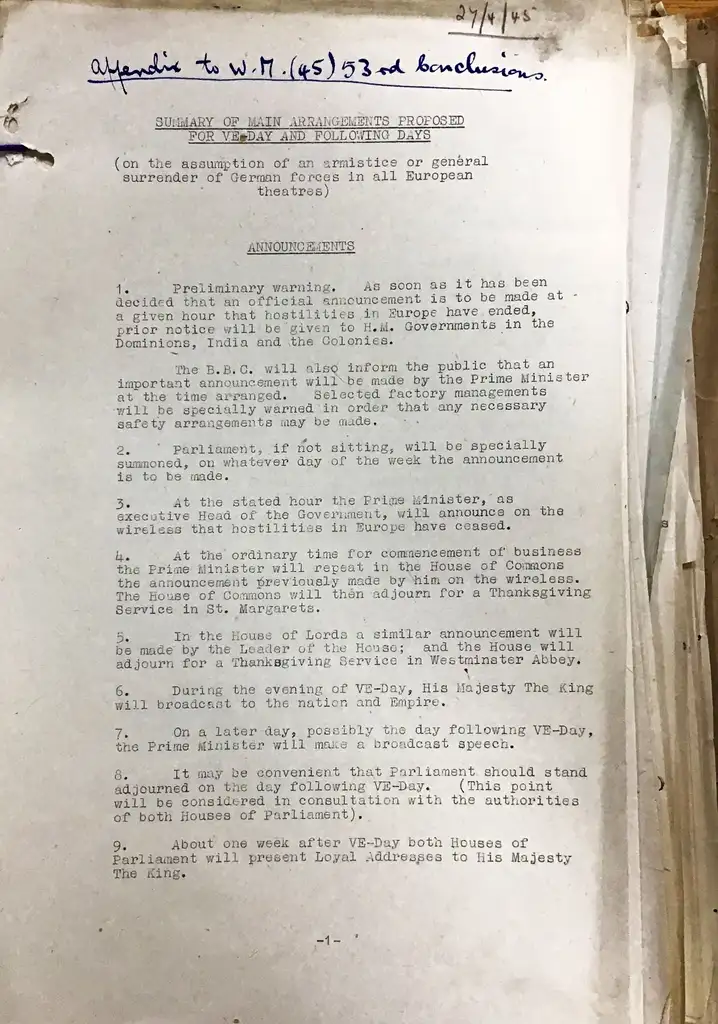
- Date
- 1944
- Catalogue reference
- CAB 21/1594
This is a summary of the official announcements which would take place in the event of an armistice or general surrender of German forces in Europe, taken from the conclusions of a Cabinet meeting in April 1945.
It sets out the process in which the public would be informed of VE Day, stating that the Prime Minister would announce the end of hostilities on the wireless, and that Parliament would be specially summoned.
Speeches would be made in Parliament, a thanksgiving service would take place, and the King would broadcast to the nation and Empire during the evening of VE Day itself.
Instructions to Allied armed forces regarding the celebration of VE Day

- Date
- 1945
- Catalogue reference
- WO 219/1254
This message was sent to military units stationed in northwest Europe in the middle of April 1945 in anticipation of the official end of hostilities. It warned that extra camp celebrations were to be discouraged, but that units could arrange – locally – celebrations including church services, meals, games, and entertainments. No extra rations or supplies would be provided for these purposes.
For many in the frontline services, there was still a lot of work to do, despite the cessation of the fighting – order still had to be kept, enemy soldiers had to be disarmed, while many were aiding refugees or those recently liberated from concentration camps across the continent. The continuing war with Japan was also still a major concern.
Instructions for the display of the flags of Allied nations on public offices after VE Day
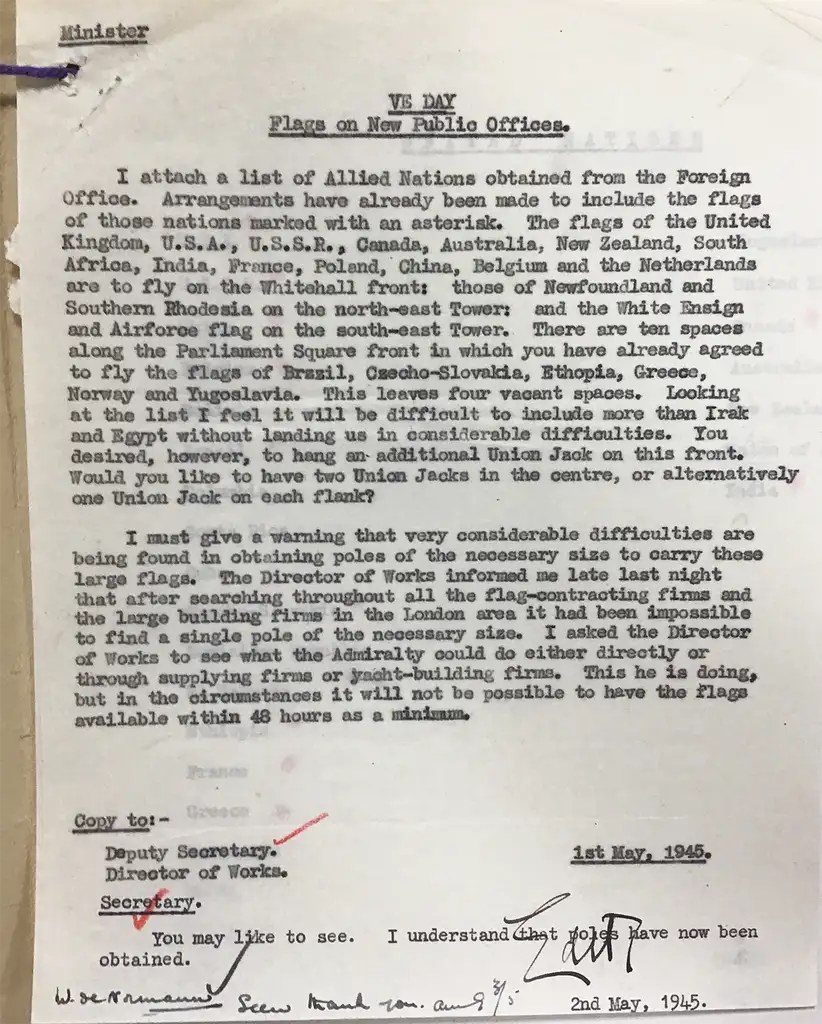
- Date
- 1945
- Catalogue reference
- WORK 21/204
Plans were put in place to fly the flags of the Allied Nations from the Foreign Office. The selection of these flags was largely unproblematic, but political considerations did still play a part in the final choices for the display. These political considerations continued to affect other events, especially the victory parade held in London in June 1946.
The limitations of wartime supplies were also highlighted in these plans as, initially, it was found that no poles of the size required to carry the large flags could be located in the London area by the Director of Works. This was, however, eventually rectified.
Scene outside The Swan – VE Day children’s treat
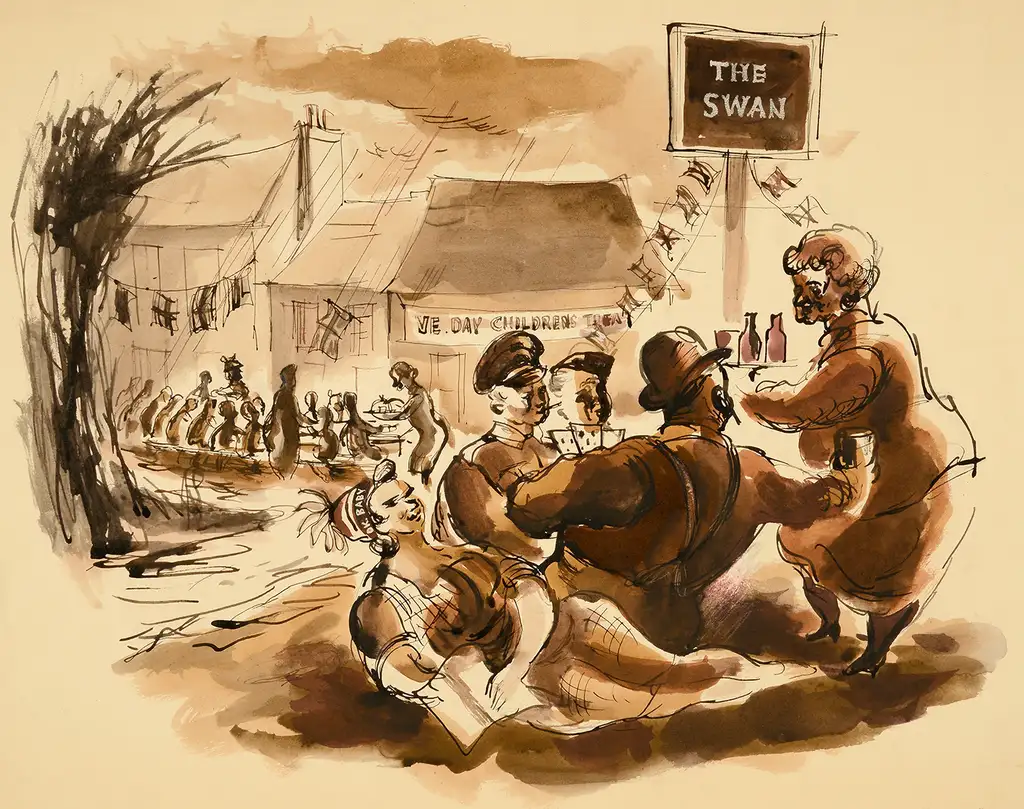
- Date
- 1945
- Catalogue reference
- INF 3/1199
This watercolour was produced for the Ministry of Information, to be used as an illustration for a magazine article about VE Day celebrations. Little is known about the artist or where specifically it was published.
It shows an idyllic English village scene, so typical of much of the propaganda produced during the Second World War, and the celebrations which marked the end of the conflict in May 1945. In particular, it depicts in the background a children’s tea party, which was to be a common feature of many of the celebrations across the country. These were often held alongside other street parties, while bonfires also became a common feature of these gatherings.
Metropolitan Police report on the victory celebrations in London on VE Day
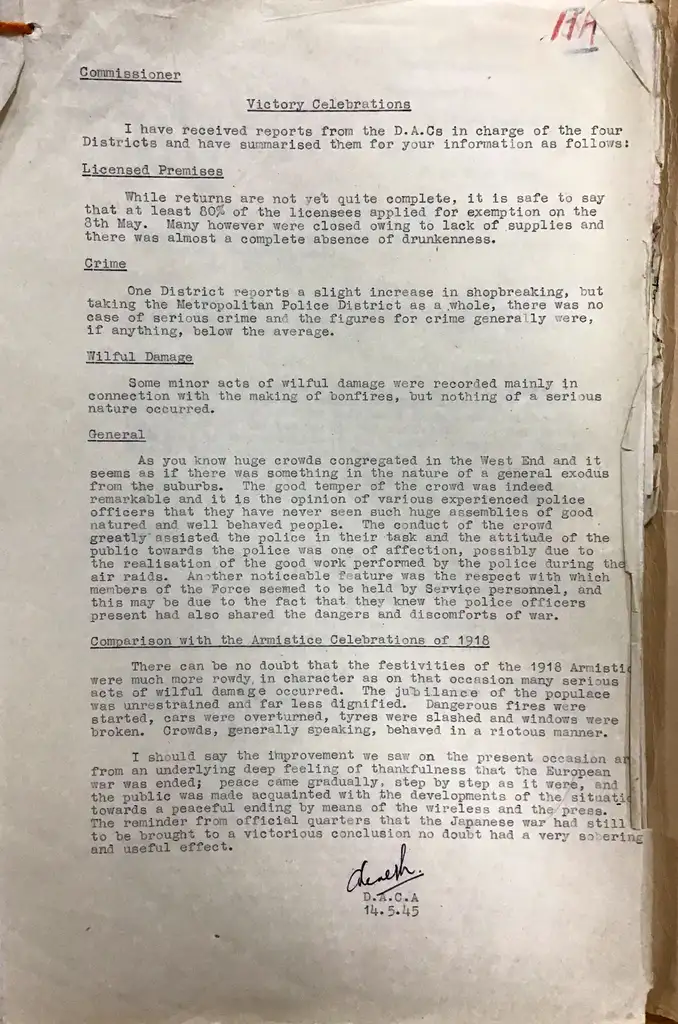
- Date
- 1945
- Catalogue reference
- MEPO 2/6266
In the week after VE Day, the Metropolitan Police circulated this summary of the victory celebrations in London. It focused on any increase in crime or wilful damage caused by those celebrating the end of hostilities. It also provides an insight into the behaviour of the crowds, who had flocked, in ‘a general exodus’, from the suburbs into central London.
Interestingly, the report also makes comparisons to the celebrations which took place after the armistice had been signed ending the First World War in November 1918. The feeling was that those in 1918 were ‘much more rowdy in character’ and that ‘crowds, generally speaking, behaved in a riotous manner’. In 1945, it describes a feeling of thankfulness, and that the public had heeded the reminder that the war with Japan was still to be brought to an end.
A message sent from the Prime Minister to people of the British Empire in Japanese occupied territories announcing VE Day
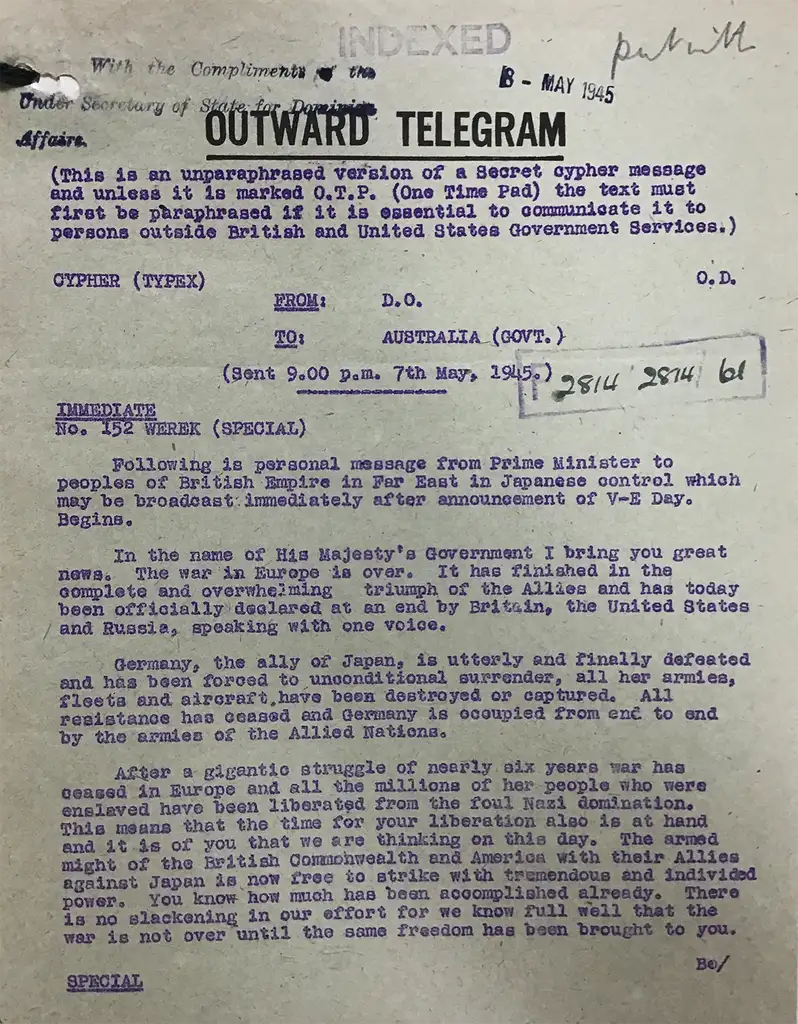
- Date
- 1945
- Catalogue reference
- FO 371/46367
Shortly after the official announcement of the end of hostilities in Europe, the Prime Minister, Winston Churchill, through the British Dominions Office, sent this telegram announcing VE Day to be broadcast to ‘peoples of British Empire in Far East in Japanese control’.
It emphasised that with the war in Europe over, it meant that ‘the time for your liberation also is at hand and it is of you that we are thinking on this day’. With Europe now free from enslavement, the armed might of the Allied forces ‘is now free to strike with tremendous and undivided power’. Crucially, it emphasised that that there would be no reduction in effort, and that the war was not over until they were brought to freedom.